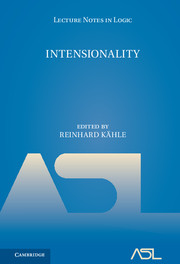Book contents
- Frontmatter
- Preface
- Contents
- The modal aether
- Possible worlds semantics for predicates
- A context principle
- The semantics of modal predicate logic II. Modal individuals revisited
- Intensionality and coercion
- Intensionality in philosophy andmetamathematics
- Representation theorem for models of dynamic intensional logic
- Intension, intention
- Modality, mood, and descriptions
- Coercion vs. indeterminacy in opaque verbs
- References
Intensionality and coercion
Published online by Cambridge University Press: 30 March 2017
- Frontmatter
- Preface
- Contents
- The modal aether
- Possible worlds semantics for predicates
- A context principle
- The semantics of modal predicate logic II. Modal individuals revisited
- Intensionality and coercion
- Intensionality in philosophy andmetamathematics
- Representation theorem for models of dynamic intensional logic
- Intension, intention
- Modality, mood, and descriptions
- Coercion vs. indeterminacy in opaque verbs
- References
Summary
Abstract. Frege informally characterized intension or Sinn as Art des Gegebenseins, that is, ‘mode of presentation’ of an object or event. The linguistic phenomenon of coercion, as exemplified by the shift in aspectual class of the verb ‘love’ from state in (a) to activity in (c):
(a) I love her.
(b) * I am loving her.
(c) I am loving her more and more every day, the more I get to know her.
thus falls in the domain of intensional phenomena. We present a fully computational theory of aspectual coercion, based on the event calculus of Aritificial Intelligence, as reformulated in constraint logic programming. The cognitive background of this formalism, as well as other applications to tense and aspect, can be found in the authors’ The Proper Treatment of Events (Blackwell 2004).
Aspectual coercion as an intensional phenomenon. Ever since Vendler's famous classification of verbs with respect to their time schemata, linguists have distinguished at least four aspectual classes or Aktionsarten. These classes comprise states, activities, accomplishments, achievements and points, which are exemplified in (1) to (5).
(1) States: know, love, be beautiful.
(2) Activities: run, push a cart, draw.
(3) Accomplishments: cross the street, build a house, draw a letter.
(4) Achievements: begin, reach, arrive.
(5) Points: flash, spot, blink.
Several linguistic tests were developed to distinguish aspectual classes. For example, adverbial modification with for two hours is possible with activities (John ran for two hours) but not with accomplishments (*John built a house for two years) or achievements. Temporal modification with the adverbial in two hours shows the reverse pattern. Usually only activities and accomplishments can occur in the progressive. Expressions like *knowing the answer are ungrammatical. But there is also a crucial difference in the behaviour of activities and accomplishments with respect to their progressivised forms. From John was pushing a cart we can infer that John pushed a cart. However, the inference from John was crossing the street to John crossed the street is invalid. This phenomenon was dubbed the “imperfective paradox” by Dowty.
- Type
- Chapter
- Information
- Intensionality , pp. 97 - 122Publisher: Cambridge University PressPrint publication year: 2005



